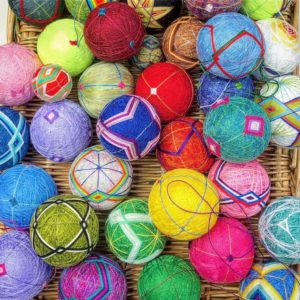
Updated December 26, 2019.
Over the weekend I came across a question about using needlepoint thread for other crafts.
Trying other needlecrafts is a great way to use up your stash, especially to use for practice when you are learning. So today we’ll talk about that, forst with some general considerations then with some additional stuff for specific crafts.
First off, use your uncut skeins for this. For most other needlecrafts, you need long pieces of thread. Our cut lengths of 18 inches to a yard won’t work.
Second, when learning almost any needlecraft, single strand threads work better than stranded threads because the thread is easier to pick up cleanly. Save your stranded stuff for something else.
Third, try to match the thread thickness you use with the thickness of other threads used for this craft. You wouldn’t tat with tapestry wool, nor would you learn crochet with #12 perle. Look on the Internet or go to a local shop to find the weight of thread used.
Fourth, pick middle to light values. Dark threads are harder to see when it’s completed and you need it as a reference.
Fifth, you probably won’t have enough thread for a project, so go out and buy the recommended thread here.
Now on to the specifics:
Weaving: I have a baby blanket my mom wove out of #5 perle cotton. Weaving uses LOTS of yarn, so you probably don’t have enough. The warp (vertical) threads are under great tension so you need something such as perle or linen for the warp. You almost certainly will need to buy this thread. Anything can go for the weft (horizontal) threads.
There are also many smaller looms to consider using. Pin looms can use wool threads of various kinds and are quite small. I also have a bracelet loom where I plan to use pearl cotton as the warp and assorted threads in various colors to make bracelets.
Embroidery of all kinds: Of course you can use needlepoint threads, even cut ones for this.
Punchneedle: Here is where you will want to use your stranded threads (1-3 strands of floss is common here) and crewel wool. Valdani packages their floss in three-strand balls that were made to make punchneedle easier.
Rug Hooking: If you are doing rug hooking with yarn rather than strips of cloth, pick thicker threads, such as tapestry wool. If you are latch-hooking, you will need to cut the yarn to specific lengths.
Tatting & Lacemaking: These need very fine threads, so look at you thinnest, single strand threads, such as #8 or #12 perle in cotton or silk.
Temari: Perle #5 and metallics are both wonderful for temari and are among the most common threads used for the decorative part. I have also successfully used crewel wool instead of sewing thread for the top of the wrapped ball. It’s a more rustic look but very cool.
Knitting & Crochet: Just about anything that follows the general rules will work here. In fact, many of the threads we love for needlepoint also live under other names as yarns for knitting & crochet. Silk & Ivory is a knitting yarn, for example. Other threads, such as tapestry wool are the same weight as knitting yarns (it’s about a worsted weight yarn).
So go ahead, use your stash and branch out into other crafts.
About Janet M Perry
Janet Perry is the Internet's leading authority on needlepoint. She designs, teaches and writes, getting raves from her fans for her innovative techniques, extensive knowledge and generous teaching style. A leading writer of stitch guides, she blogs here and lives on an island in the northeast corner of the SF Bay with her family

bunka is used quite a bit in miniatures, I’ve seen people knit with straight pins uing 1 strand of DMC. In all my mini mgs there are crochet patterns every month. Mini NP is done with a single strand of DMC on silk gauze. I know that punchneedle is done for mini rugs but none of the details.